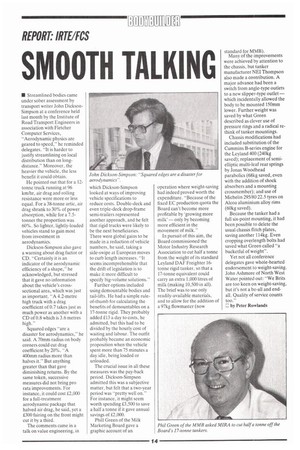SMOOT TALKING
Page 98

If you've noticed an error in this article please click here to report it so we can fix it.
• Streamlined bodies came under sober assessment by transport writer John DicksonSimpson at a conference held last month by the Institute of Road Transport Engineers in association with Fletcher Computer Services, "Aerodynamic physics are geared to speed," he reminded delegates. "It is harder to justify streamlining on local distribution than on longdistance." Moreover, the heavier the vehicle, the less benefit it could obtain.
He pointed out that for a 12tonne truck running at 96 km/hr, air drag and rolling resistance were more or less equal. For a 38-tonne artic, air drag shrank to 30% of power absorption, while for a 7.5tonner the proportion was 60%. So lighter, lightly-loaded vehicles stand to gain most from investment in aerodynamics.
Dickson-Simpson also gave a warning about drag factor or CD. "Certainly it is an indicator of the aerodynamic efficiency of a shape," he acknowledged, but stressed that it gave no information about the vehicle's crosssectional area, which was just as important. "A 4.2-metre high truck with a drag coefficient of 0.7 takes just as much power as another with a CD of 0.8 which is 3.6 metres high."
Squared edges "are a disaster for aerodynamics," he said. A 70mm radius on body corners could cut drag coefficient by 20%. "A 400mm radius more than halves it." But anything greater than that gave diminishing returns. By the same token, successive measures did not bring pro rata improvements. For instance, it could cost £2,000 for a full-treatment aerodynamic package that halved air drag, he said, yet a £300 fairing on the front might cut it by a third.
The comments came in a talk on value engineering, in which Dickson-Simpson looked at ways of improving vehicle specifications to reduce costs. Double-deck and even triple-deck drop-frame semi-trailers represented another approach, and he felt that rigid trucks were likely to be the next beneficiaries. There were global gains to be made in a reduction of vehicle numbers, he said, taking a side-swipe at European moves to curb length increases. "lt seems incomprehensible that the drift of legislation is to make it more difficult to specify big-volume solutions."
Further options included using demountable bodies and tail-lifts. He had a simple ruleof-thumb for calculating the benefits of demountables on a 17-tonne rigid. They probably added £13 a day to costs, he admitted, but this had to be divided by the hourly cost of waiting and labour. The outfit probably became an economic proposition when the vehicle spent more than 75 minutes a day idle, being loaded or unloaded.
The crucial issue in all these measures was the pay-back period. Dickson-Simpson admitted this was a subjective matter, but felt that a two-year period was -pretty well on." For instance, it might seem worth spending £3,500 to save a half a tonne if it gave annual savings of £2,000.
Phil) Green of the Milk Marketing Board gave a graphic account of an operation where weight-saving had indeed proved worth the expenditure. "Because of the fixed EC production quota the Board can't become more profitable by 'growing more milk' — only by becoming more efficient in the movement of milk."
In pursuit of this aim, the Board commissioned the Motor Industry Research Association to cut half a tonne from the weight of its standard Leyland DAF Freighter 16tonne rigid tanker, so that a 17-tonne equivalent could carry an extra 1,000 litres of milk (making 10,500 in all). The brief was to use only readily-available materials, and to allow for the addition of a 97kg flowmaster (now
standard for MMB).
Many of the improvements were achieved by attention to the chassis, but tanker manufacturer NEI Thompson also made a contribution. A major advance had been a switch from angle-type outlets to a new slipper-type outlet — which incidentally allowed the body to be mounted 150mm lower. Further weight was saved by what Green described as clever use of pressure rings and a radical rethink of tanker mountings.
Chassis modifications had included substitution of the Cummins B-series engine for the Leyland 400 (240kg saved); replacement of semielliptic multi-leaf rear springs by Jonas Woodhead parabolics (68kg saved, even with the addition of shock absorbers and a mounting crossmember); and use of Michelin 295/80 22.5 tyres on Alcoa aluminium alloy rims (60kg saved).
Because the tanker had a full six-point mounting, it had been possible to delete the usual chassis flitch plates, saving another 114kg. Even cropping overlength bolts had saved what Green called "a bucketful of weight".
Yet not all conference delegates gave whole-hearted endorsement to weight-saving. John Ashmore of North West Water pointed out: "We Brits are too keen on weight-saving, but it's not a be-all and endall. Quality of service counts too."
E by Peter Rowlands
























































































































